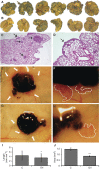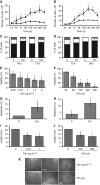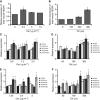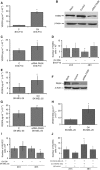The fatty acid synthase inhibitor orlistat reduces experimental metastases and angiogenesis in B16-F10 melanomas
- PMID: 22892389
- PMCID: PMC3464771
- DOI: 10.1038/bjc.2012.355
The fatty acid synthase inhibitor orlistat reduces experimental metastases and angiogenesis in B16-F10 melanomas
Abstract
Background: Fatty acid synthase (FASN) is overexpressed and associated with poor prognosis in several human cancers. Here, we investigate the effect of FASN inhibitors on the metastatic spread and angiogenesis in experimental melanomas and cultured melanoma cells.
Methods: The lung colonisation assay and cutaneous melanomas were performed by the inoculation of mouse melanoma B16-F10 cells in C57BL6 mice. Blood vessel endothelial cells (RAEC and HUVEC) were applied to determine cell proliferation, apoptosis, and the formation of capillary-like structures. Vascular endothelial growth factor A (VEGFA) expression was evaluated by quantitative RT-PCR and ELISA in B16-F10, human melanoma (SK-MEL-25), and human oral squamous carcinoma (SCC-9) cells. Conditioned media from these cancer cell lines were used to study the effects of FASN inhibitors on endothelial cells.
Results: B16-F10 melanoma-induced metastases and angiogenesis were significantly reduced in orlistat-treated mice. Fatty acid synthase inhibitors reduced the viability, proliferation, and the formation of capillary-like structures by RAEC cells, as well as the tumour cell-mediated formation of HUVEC capillary-like structures. Cerulenin and orlistat stimulated the production of total VEGFA in B16-F10, SK-MEL-25, and SCC-9 cells. Both drugs also enhanced VEGFA(121), (165), (189,) and (165b) in SK-MEL-25 and SCC-9 cells.
Conclusion: FASN inhibitors reduce metastasis and tumour-induced angiogenesis in experimental melanomas, and differentially modulate VEGFA expression in B16-F10 cells.
© 2012 Cancer Research UK
Conflict of interest statement
The authors declare no conflict of interest.
Figures


 ; G2/M; *P<0.05, t-test). (E and F) 3 (4,5-dimethylthiazol-2-yl)-2,5 diphenyltetrazolium bromide experiments showing that the viability of RAEC cells is reduced by cerulenin or orlistat in a dose–response manner (*P<0.05, t-test). (G and H) The percentage of B16-F10 cells in apoptosis was significantly enhanced following the treatment with 0.75 μg ml−1 of cerulenin or 100 μℳ of orlistat for 48 h (*P<0.05, t-test). (I–L) The length of capillary-like structures formed by RAEC cells in matrigel was significantly reduced by both drugs (C: control with dimethyl sulfoxide for cerulenin or ethanol for orlistat; cer: cerulenin; orl: orlistat; original magnification in K: × 40).
; G2/M; *P<0.05, t-test). (E and F) 3 (4,5-dimethylthiazol-2-yl)-2,5 diphenyltetrazolium bromide experiments showing that the viability of RAEC cells is reduced by cerulenin or orlistat in a dose–response manner (*P<0.05, t-test). (G and H) The percentage of B16-F10 cells in apoptosis was significantly enhanced following the treatment with 0.75 μg ml−1 of cerulenin or 100 μℳ of orlistat for 48 h (*P<0.05, t-test). (I–L) The length of capillary-like structures formed by RAEC cells in matrigel was significantly reduced by both drugs (C: control with dimethyl sulfoxide for cerulenin or ethanol for orlistat; cer: cerulenin; orl: orlistat; original magnification in K: × 40).



Similar articles
-
Effects of fatty acid synthase inhibitors on lymphatic vessels: an in vitro and in vivo study in a melanoma model.Lab Invest. 2017 Feb;97(2):194-206. doi: 10.1038/labinvest.2016.125. Epub 2016 Dec 5. Lab Invest. 2017. PMID: 27918556
-
Fatty acid synthase inhibition with Orlistat promotes apoptosis and reduces cell growth and lymph node metastasis in a mouse melanoma model.Int J Cancer. 2008 Dec 1;123(11):2557-65. doi: 10.1002/ijc.23835. Int J Cancer. 2008. PMID: 18770866
-
Inhibition of fatty acid synthase in melanoma cells activates the intrinsic pathway of apoptosis.Lab Invest. 2011 Feb;91(2):232-40. doi: 10.1038/labinvest.2010.157. Epub 2010 Aug 30. Lab Invest. 2011. PMID: 20805790
-
The antimetastatic activity of orlistat is accompanied by an antitumoral immune response in mouse melanoma.Cancer Chemother Pharmacol. 2020 Feb;85(2):321-330. doi: 10.1007/s00280-019-04010-1. Epub 2019 Dec 20. Cancer Chemother Pharmacol. 2020. PMID: 31863126
-
Fatty acid synthase inhibitors induce apoptosis in non-tumorigenic melan-a cells associated with inhibition of mitochondrial respiration.PLoS One. 2014 Jun 25;9(6):e101060. doi: 10.1371/journal.pone.0101060. eCollection 2014. PLoS One. 2014. PMID: 24964211 Free PMC article.
Cited by
-
Candidate biomarker discovery for angiogenesis by automatic integration of Orbitrap MS1 spectral- and X!Tandem MS2 sequencing information.Genomics Proteomics Bioinformatics. 2013 Jun;11(3):182-94. doi: 10.1016/j.gpb.2013.02.002. Epub 2013 Apr 2. Genomics Proteomics Bioinformatics. 2013. PMID: 23557902 Free PMC article.
-
LncRNA RPARP-AS1 promotes the progression of osteosarcoma cells through regulating lipid metabolism.BMC Cancer. 2024 Feb 2;24(1):166. doi: 10.1186/s12885-024-11901-x. BMC Cancer. 2024. PMID: 38308235 Free PMC article.
-
Deciphering endothelial heterogeneity in health and disease at single-cell resolution: progress and perspectives.Cardiovasc Res. 2023 Mar 17;119(1):6-27. doi: 10.1093/cvr/cvac018. Cardiovasc Res. 2023. PMID: 35179567 Free PMC article.
-
Endothelial tip cells in vitro are less glycolytic and have a more flexible response to metabolic stress than non-tip cells.Sci Rep. 2019 Jul 18;9(1):10414. doi: 10.1038/s41598-019-46503-2. Sci Rep. 2019. PMID: 31320669 Free PMC article.
-
Lipid metabolism in cancer progression and therapeutic strategies.MedComm (2020). 2020 Dec 24;2(1):27-59. doi: 10.1002/mco2.27. eCollection 2021 Mar. MedComm (2020). 2020. PMID: 34766135 Free PMC article. Review.
References
-
- Alli PM, Pinn ML, Jaffee EM, McFadden JM, Kuhajda FP (2005) Fatty acid synthase inhibitors are chemopreventive for mammary cancer in neu-N transgenic mice. Oncogene 24: 39–46 - PubMed
-
- Almeida JP, Coletta RD, Silva SD, Agostini M, Vargas PA, Bozzo L, Graner E (2005) Proliferation of fibroblasts cultured from normal gingiva and hereditary gingival fibromatosis is dependent on fatty acid synthase activity. J Periodontol 76: 272–278 - PubMed
-
- Alò PL, Visca P, Framarino ML, Botti C, Monaco S, Sebastiani V, Serpieri DE, Di Tondo U (2000) Immunohistochemical study of fatty acid synthase in ovarian neoplasms. Oncol Rep 7: 1383–1388 - PubMed
-
- Bates DO, Cui TG, Doughty JM, Winkler M, Sugiono M, Shields JD, Peat D, Gillatt D, Harper SJ (2002) VEGF165b, an inhibitory splice variant of vascular endothelial growth factor, is down-regulated in renal cell carcinoma. Cancer Res 62: 4123–4131 - PubMed
-
- Browne CD, Hindmarsh EJ, Smith JW (2006) Inhibition of endothelial cell proliferation and angiogenesis by orlistat, a fatty acid synthase inhibitor. FASEB J 20: 2027–2035 - PubMed
Publication types
MeSH terms
Substances
LinkOut - more resources
Full Text Sources
Other Literature Sources
Medical
Research Materials
Miscellaneous

